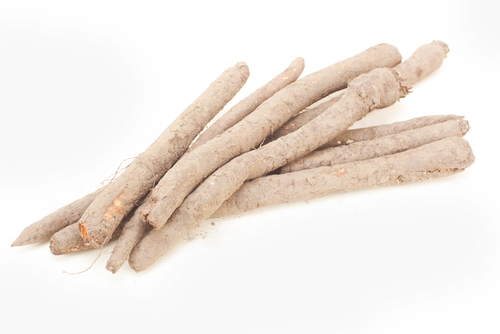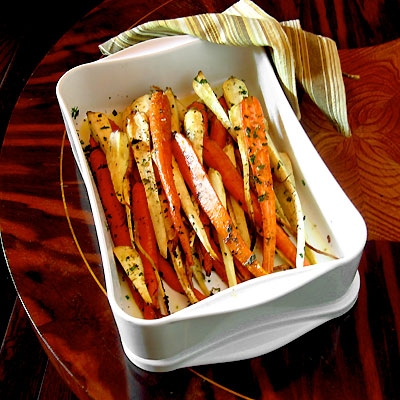
This week at the Hollywood Farmers Market I was on my weekly crawl to find something interesting. But I had a secret; I actually had a plan this time. I had my sites set on salsify.
What is salsify you ask? Maybe you know it better as oyster plant or goatsbeard. No?
It’s an ancient plant, long utilized as food. It is related to the sunflower and is in the family Asteraceae, which makes it, basically, a wildflower. But this information probably does not help you identify it because we don’t eat the flowers. Or at least I don’t eat the flowers…they’re just too darn pretty!
As a food, salsify is primarily a root vegetable. But the green grass-like leaves and stems are edible and often sold still attached to the root.
The root looks a lot like a big, skinny, hairy, parsnip. It is between six and twelve inches long. It is a cream colored with lots of little rootlets sprouting out of it in all directions. There is a black version, but botanically they are not closely related. Personally I have never seen the black type.
But why salsify…and more particularly why salsify now? Shouldn’t I be on the look out for mandarins or walnuts? These are typically the prizes of the December harvest in Southern California.
 And it’s true, these things are reaching their peak right now and I may become transfixed by one of them next week at the Farmers Market. But this is this week I have salsify on the brain.
And it’s true, these things are reaching their peak right now and I may become transfixed by one of them next week at the Farmers Market. But this is this week I have salsify on the brain.
The weather has turned crisp recently. Rain is predicted. The local news anchors are on 24/7 “STORM WATCH”. Phrases like “Arctic Blast” and “Bone Chilling” are being bantered about. That has created a salsify window that I cannot ignore.
These are the conditions necessary to bring salsify to the Farmers Market. Or more precisely, these are the conditions necessary to bring good salsify to the Farmers Market.
Salsify is often mature enough to harvest as early as June. But it is way better during winter. It needs to be exposed to chilly ground temperatures for a few weeks. The colder temperatures help convert its starches into sugar. So salsify actually sweetens, as the weather gets colder. But it is a Mediterranean plant and may die back to the ground once the weather gets too cold or stays too cold for too long.
Being a native of the Mediterranean region it is a good choice for us, and grows well in southern California. But you aren’t likely to find it in your local grocery stores.
This is partly due to its slightly difficult storage and handling problems. Salsify does not freeze well so the Jolly Green Giant has passed it over in favor of other more freezer friendly veggies.
Salsify is similar to a banana, or artichoke in that it discolors the moment it is peeled, or sliced, or chopped. It should be dropped into lemon water until ready to cook or serve raw.
It is also a bit hard to harvest. It is a brittle root, often breaking when pulled from the ground. When this happens, it must be used at once as it will quickly discolor and possibly spoil.
Some say it tastes like an oyster. Well, not any oyster I ever ate. But they do call it oyster plant, so somebody must think so. The flavor to me is more like an artichoke, or maybe even a sun choke…slightly nutty. It’s at its best shortly after harvest while still sweet. It can revert to its starchy summer self after it has been stored awhile.
So here I am back from the market with 2 big roots. What I am going to do with them? I am going to have to think about that.
While I do, I’ll need to store them…and store them well, because they are best fresh, very fresh.
Salsify can be refrigerated in a perforated plastic bag for up to a week. But do not wash it before use. It will deteriorate quicker.
Salsify is difficult to clean and peel, if you plan to do this before cooking you should acidulate the water. But remember, if it works for your recipe, they can be peeled more easily after cooking.
Salsify is better steamed than boiled. It can break apart easily so do not overcook it. It turns from succulent to mushy in the blink of an eye, so have an ice bath ready to stop the cooking process.
Salsify is excellent in soups and stews. And so much easier to deal with this way. Given the weather, a Creamy Salsify Soup with Salmon is exactly what I have in mind. Besides with its starchy nature I just think that it works better in conjunction with other flavors. It can add a depth and interest that potato just can’t match.
As my jumping off point I am turning to a soup from Daniel Boulud’s CAFÉ BOULUD cookbook. He does a basic creamy potato based soup that is hard to beat.
I am going to make a few minor changes to the base of the soup. (He won’t mind). Plus, I am adding some leftover shards of salmon and dill as a garnish. Not to mention the addition of my wrangley, ugly, (but tasty) salsify; I know I am going to get a comforting, yet deeply compelling soup. Perfect for the chill in the air!
Creamy Salsify Soup with Salmon
serves 6 CLICK here for a printable recipe
- 4 T unsalted butter
- 3 (1 oz) chunks, pancetta or slab bacon
- 1 large onion peeled, trimmed, and thinly sliced
- 1 fennel bulb, trimmed peeled, trimmed, and thinly sliced
- 1 celery stalk, peeled, trimmed, and thinly sliced
- 3 clv garlic
- 1 pn each salt and white pepper, as needed
- 1 oz bouquet garni made with 3 large basil leaves, 2 parsley sprigs, 1 thyme sprig and 1 bay leaf
- 1 lb salsify root
- 1 qt chicken stock
- 1 potato
- 1/2 c heavy cream
- 6 oz roasted salmon, torn into shards
- 1 T dill leaves, chopped
Melt the butter in a Dutch oven or large casserole over medium heat. Add the pancetta or bacon and cook, stirring occasionally, until it renders its fat, 3 to 5 minutes. Add the onion, fennel, leeks, celery, and garlic and season with salt and pepper. Toss in the bouquet garni and cook, stirring occasionally, about 8 mins
Right before ready to use, run the salsify under cool water and scrub clean. Do not peel entirely, but you may break off some of the small rootlets if you like. Cut the salsify into one-inch chunks and add them to the pan. Cook them all together about 10 minutes more.
Pour in the stock, add the potatoes and a pinch of salt, and bring the mixture to the low boil. Lower the heat and simmer, about 30 mins. Skim off any scummy bubbles as you go. Remove all three pieces of pancetta or bacon, save them for another use. Discard the bouquet garni.
Add the cream. Using an immersion blender, puree the soup until it is creamy. Strain the soup through a mesh sieve into a large saucepan and taste for salt and pepper. Adding as needed. Add the cream to the soup and bring to a low boil. Lower heat and serve warm, ganished with salmon shards and dill.
Greg Henry writes the food blog Sippity Sup- Serious Fun Food, and contributes the Friday column on entertaining for The Back Burner at Key Ingredient. He’s active in the food blogging community, and a popular speaker at IFBC, Food Buzz Festival and Camp Blogaway. He’s led cooking demonstrations in Panama & Costa Rica, and has traveled as far and wide as Norway to promote culinary travel. He’s been featured in Food & Wine Magazine, Los Angeles Times, More Magazine, The Today Show Online and Saveur’s Best of the Web. Greg also co-hosts The Table Set podcast which can be downloaded on iTunes or at Homefries Podcast Network.
- Follow Greg on Twitter @SippitySup
- Follow The Table Set on Twitter @TheTableSet
- Like Sippity Sup on Facebook


This one is a real winner, as are you my friend.
LL
Sounds like a super combination!
Love love love this beautiful recipe. Salmon, spinach, and feta are three of my favorite ingredients, and I love the way you combined them, so simply and elegantly. Keep posting, don’t overthink it. You have a legion of fans out there.
Greg- you are a great blogger and been a fan for years! What a fantastic recipe — this is a keeper. You make fantastic videos — I still love the one you did for project food blog!
… it’s tricky keeping multiple balls in the air. And it’s hard for any blogger to not become a little crazy about the numbers. For the most part, I try to ignore the stats, but … And I try not to get too upset when I don’t get a lot of comments, but … Anyway, that salmon is cute as a bug! I’m a sucker for anything with kitchen twine.
i am not a sea food fan but my dad is. i will make this for him next time he visits …he will really like it with the stufed spinach!
i don’t love salmon, but this sounds so good i want to cook and eat it immediately! yum!!
I love reading your blog and appreciate your writing and content honesty, I wish I could comment more but I always have problems, here’s hoping this one gets through!!
You are totally not coasting, hang in there! Can’t wait to make some savory pies. 😉
While I don’t quite have the same directional pull at my time as you do, I do understand the neediness of the blog!! When i started blogging I had NO idea how much time it would take, nor how much I would come to love it. My husband and I have actually argued over the time that I spend on it, and while I don’t make much $ to speak of, it’s become a passion none the less.
I’m a bit out of the loop and didn’t know about your cookbook in the works, and might I just say congratulations!!! I’m really excited for you, and I absolutely can’t imagine the time that you are putting into it. The benefits will be worth it though! And I absolutely can’t wait to see the final product!
Ok… the salmon… wow! This one would make my husband a happy man. Now that school is out and the dance season is coming to a close I may actually have time to spend on special dinners. This one will be top of my list!
You’re one of the most talented people I’ve been lucky enough to meet since I started blogging. Not a writer? Not a chef? Are you kidding?! I’m sure the downtick in traffic is temporary and I see your cookbook only increasing it down the road. Can’t wait until it comes out.
Hey, I still come and visit your blog often 🙂 And I’m looking forward to your new cookbook. Let me know when they come out, need to get myself a copy.
Secondly, your salmon looks divine. Wish we were neighbors so I can stop by for dinner (or a drink…).
Greg,
You are a great blogger. And I am truly appreciative of all the comments I get from you on my blog, especially considering how busy you are. Can’t wait to see your book.
Best,
Jameson
Such a thoughtful piece, Greg! I can only imagine how busy you are now and how much stress you’re under. But know that you are a talented writer and your recipes and blog posts are always so lovely. I’m so looking forward to your book.
First food, the salmon looks divine — I make something very similar but with basil & ricotta — I like the spinach/feta combo!
Now thought, you are very talented and have created a wonderful blog and that’s a fact, and even very successful people have peaks and troughs during their careers, keep going.
Can’t wait for the book!
My numbers have dropped as I got busier — I wish I could have my cake and eat it too
As a new reader of your blog I can tell that your honesty in writing was what captivated me. I had no idea you were working on a cookbook…congratulations!! I also have no idea how blogs make money. You could write an article about that…tons of people would be interested…I just thought all of this was a hobby. Money? Really? Advertisers and companies contact me but they just want my articles and photos for free. No one seems interested in paying a dime and it has become embarrassing to broach the subject. So…I just go my merry way and toodle in the kitchen and then toodle with my camera. Glad to have found you and good luck with the business in your life at the moment! You can do it!
Well if it makes you feel any better, my stats have dropped off in the last few months also and I dont even have a cookbook to blame it on! …so maybe it’s just that less people are reading blogs? I for one have not noticed any decline in the quality of your content…in fact, I want to make this salmon immediately! perhaps for father’s day…
Ha ha ha, sorry, couldn’t resist that one.
I suspect part of it is being preoccupied. But I think part of it is also outreach. I noticed that I haven’t spent as much time finding new bloggers, new readers, etc. At the same time, some of my existing base quit or have slacked off on blogging or reading. So our base is eroding while we are not growing new readers. At least, that’s my theory.
But I haven’t noticed any drop off in quality. Have you tried the Israeli feta at Trader Joes? Awesome.
…Bulgarian feta it’s hard to try other kinds. But I will! GREG
I’m still here, reading and totally enjoying your posts! I love your unique style with food and with words. I am so looking forward to your Savory Pies book! What a great topic! I’m afraid you may soon have to call yourself a professional, though. 😉
Keep at it…blogging and booking. It will all balance out!
This recipe looks great, and you could also sub beet greens for the spinach, for a change. Just an idea.
a hell of a writer! I am sure it has been VERY freaky to see your numbers drop, but have faith that your readers still love your blog and will be out in droves to buy your book! I, for one, can’t WAIT! Love so many of your blog posts, from the family anecdotes to recipes like this one!